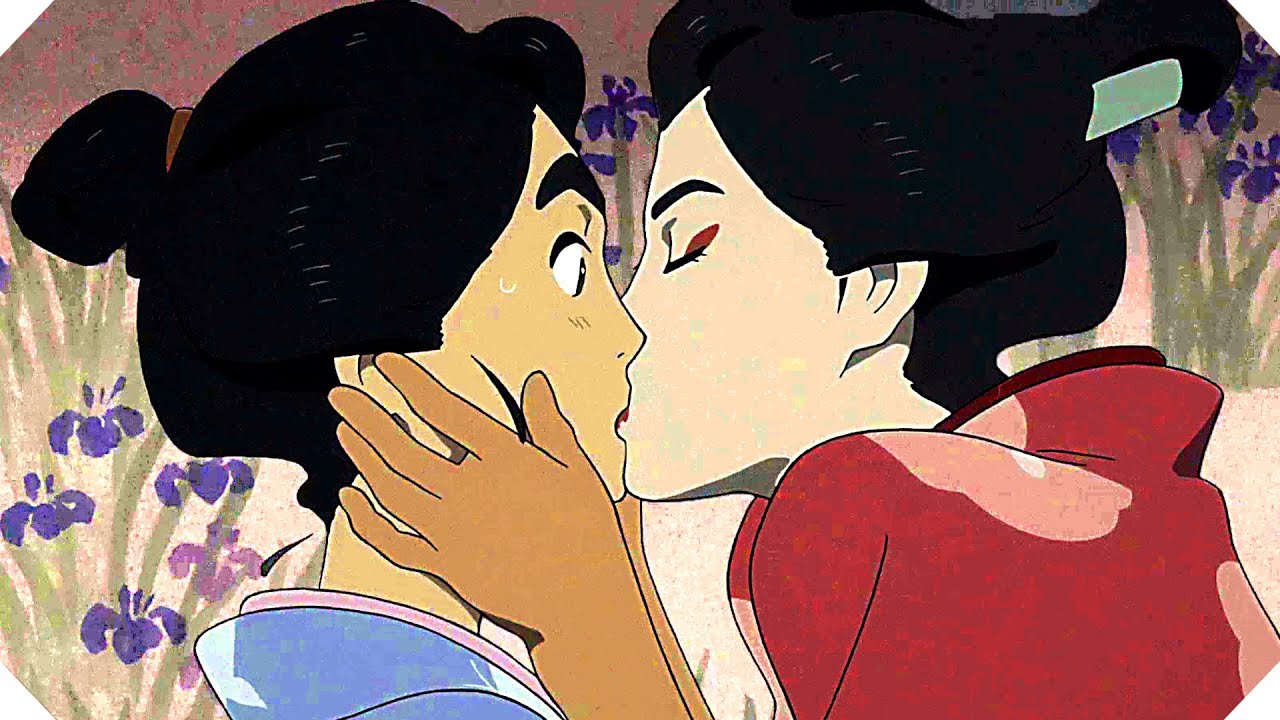By Chlotrudis Independent Film Society
Rating: 4.25 cats
Director: Keiichi Har

Original language title: Sarusuberi: Miss Hokusai
Country: japan
Year: 2016
Running time: 93
IMDB: http://www.imdb.com/title/tt3689910/combined
Jason says: “Stories about art and artists are fantastic opportunities for makers of animated films, and I suspect that if I knew more about Japanese art, I’d be even more impressed by how MISS HOKUSAI uses it to give its sweet but far from sugary story more atmosphere. Even an art dummy like me can still see that the filmmakers are doing neat things here and without being as obvious a style choice as the occasional bursts of rock & roll on the soundtrack of a movie set in 1814 Edo.
“That is when Katsushika Hokusai (voice of Yutaka Matsushige) was known as ‘Tetsuzo’ (he had many names over the course of his career), with his adult daughter O-Ei (voice of Anne Watanabe) assisting him, sometimes to the extent of doing the work for him. Another artist, former samurai Ikeda Zenjiro (voice of Gaku Hamada), lives and works with them, and other young artists come around to soak up the older man’s wisdom. Tetsuzo is divorced, and O-Ei regularly visits her mother and blind younger sister O-Nao (voice of Shion Shimizu).
“Art can appear to have literally spiritual implications in this film’s world, and I idly wonder if investigating paranormal activity connected to paintings was the recurring engine for Hinako Sugiura’s original Sarusuberi manga; Hokusai father and daughter get involved in a couple different cases over the course of the film. It’s an interesting way of keeping a film about historic figures from becoming too much just a recitation of events or speculation about their family life, spacing out the other storylines a little bit. The supernatural elements are never treated as indisputably true, but are given the sort of weight that people in this time and place would have given them.
“While Hokusai senior is the best-known of the characters appearing in the film, it is told from the perspective of O-Ei, who describes her father as a ‘nutty old man’ and has a sharp wit to go with an often grim expression. Screenwriter Miho Mauro gives her all the best lines although she is not obviously introspective in her narration, leaving the audience to observe how she is the one in the family who balances art and practicality, or the way her reactions toward the young men in her life tell her desires. Though the rest of the cast is generally more humorous in action and design, she is far from a joyless character; the scenes between O-Ei and O-Nao are tremendously sweet, and she is seldom used as a drag on the funnier bits with Tetsuzo.
“The scenes with O-Nao, intriguingly, are some of the ones where the characters’ art seems to make it into what is often a well-rendered but very modern anime style, suggesting that O-Nao’s imagination of the world as perceived through her other senses parallels her family’s artwork. It’s not the only way that this happens, though; director Keiichi Hara and his crew work various designs in so that the characters can be shown working at detailed work, or a sunset can seem to have been created in another medium. Even the CGI assistance used in creating the city’s bridges and buildings takes care to recall the period’s detailed architectural drawings.
“Hara and company keep the visual stylization to a minimum in part because they are making a fairly modern-feeling movie, with the electric guitar behind the opening scene the most obvious hint. Unlike many period Japanese pieces, MISS HOKUSAI does not spend a lot of time trafficking in formality; the characters are generally free of any sort of formal patronage or fealty, and the banter is rather bouncy. It’s not missing entirely – a subplot suggests that O-Ei may need sexual experience to improve as an artist but never pushes her to go out and get it – but in many ways these artists are unusually easy to relate to despite living in a very different time and place and, well, being artists and somewhat eccentric by nature.
“Such ease of access may be a double-edged sword; I suspect that in an ideal world MISS HOKUSAI would trigger more interest in Hokusai’s work and the environment that spawned it. There’s little denying, though, that the approach can pull even a foreign art neophyte like myself into the film to find a story worth hearing. 4.25 cats
“Seen 13 July 2015 in Theatre Hall Concordia (Fantasia International Film Festival: AXIS, DCP)”
